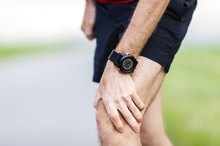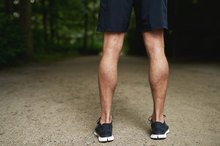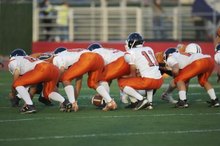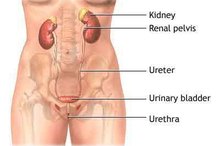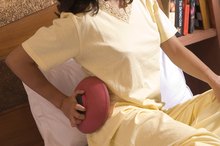What does fact checked mean?
At Healthfully, we strive to deliver objective content that is accurate and up-to-date. Our team periodically reviews articles in order to ensure content quality. The sources cited below consist of evidence from peer-reviewed journals, prominent medical organizations, academic associations, and government data.
The information contained on this site is for informational purposes only, and should not be used as a substitute for the advice of a professional health care provider. Please check with the appropriate physician regarding health questions and concerns. Although we strive to deliver accurate and up-to-date information, no guarantee to that effect is made.
About Groin & Knee Pain
Groin and knee pain can happen to just about anybody. Athletes and physically active people are more likely to experience either groin or knee pain, or both, according to MayoClinic.com 12. The groin area, where the lower abdominal muscles connect with the legs, often is under trained and under stretched. Types of knee pain can vary with age. MayoClinic.com notes young people are more susceptible to Osgood-Schlatter disease and patellar tendinitis, while osteoarthritis and gout tend to cause knee pain in older people 12.
If you are experiencing serious medical symptoms, seek emergency treatment immediately.
Groin Pain Features
Groin pain usually occurs when a muscle is strained in the lower abdominal hip area. Tearing or pulling a muscle in the groin area can be very painful. Groin injuries can also lead to other injuries around the hip area if it is not properly cared for. Icing the area for 20 to 30 minutes two to four times a day can greatly decrease the recovery time, according to MayoClinic.com 12.
- Groin pain usually occurs when a muscle is strained in the lower abdominal hip area.
- Groin injuries can also lead to other injuries around the hip area if it is not properly cared for.
Knee Pain Features
Pain Above the Knee Cap With Running
Learn More
The most common knee injuries are to the ligaments, tendons and bursae sacs. The ligaments, which connect bone to bone, are usually damaged by repeated or sudden trauma to your knee area. Some knee trauma symptoms include popping of the knee and pain when walking. The tendons are fibers that attach muscles to the bones, and these can be damaged without proper stretching and can cause swelling and the inability to straighten your knee. The bursae sacs cushion the joints in your knee and can become inflamed when damage is done to other parts of your knee.
- The most common knee injuries are to the ligaments, tendons and bursae sacs.
- The ligaments, which connect bone to bone, are usually damaged by repeated or sudden trauma to your knee area.
Symptoms
Swelling occurs to some degree with pain to the knee or groin. The groin area might contain a lump around the testicle area if there is a sharp, sudden pain. You may also have a groin injury if you have a sharp pain that stretches from your abdominals to your testicle.
Knee injuries will cause you to have trouble bending your knee, have trouble walking, tenderness and redness in the knee joint area.
- Swelling occurs to some degree with pain to the knee or groin.
- The groin area might contain a lump around the testicle area if there is a sharp, sudden pain.
Prevention/Solution
What Are the Causes of Pain in the Upper Hip or Waist Area?
Learn More
Stretch and do warm up exercises before starting any exercise program. Tendons and ligaments usually pull or tear when there is not enough blood flowing in the area or the muscles are not limber enough.
Work your leg muscles more so the muscles and tendons become stronger and less likely to tear. A light walk before doing a strenuous activity will greatly decrease your chances of muscles becoming tight in your knees and groin.
- Stretch and do warm up exercises before starting any exercise program.
- Tendons and ligaments usually pull or tear when there is not enough blood flowing in the area or the muscles are not limber enough.
Considerations
If pain in your groin or knees persists, consult a physician. If you experience a burning sensation, physical changes in the area or blood in your urine, call your doctor.
Call your doctor about your knee pain if you can't get the swelling to go down or have a hard time walking.
Related Articles
References
- MayoClinic.com: Groin Pain
- MayoClinic.com: Knee Pain
- Lespasio MJ, Piuzzi NS, Husni ME, Muschler GF, Guarino A, Mont MA. Knee Osteoarthritis: A Primer. Perm J. 2017;21:16-183. doi:10.7812/TPP/16-183
- Kiapour AM, Murray MM. Basic science of anterior cruciate ligament injury and repair. Bone Joint Res. 2014;3(2):20-31. doi:10.1302/2046-3758.32.2000241
- Doral MN, Bilge O, Huri G, Turhan E, Verdonk R. Modern treatment of meniscal tears. EFORT Open Rev. 2018;3(5):260-268. doi:10.1302/2058-5241.3.170067
- Reinking MF. CURRENT CONCEPTS IN THE TREATMENT OF PATELLAR TENDINOPATHY. Int J Sports Phys Ther. 2016;11(6):854-866.
- Petersen W, Rembitzki I, Liebau C. Patellofemoral pain in athletes. Open Access J Sports Med. 2017;8:143-154. doi:10.2147/OAJSM.S133406
- Frush TJ, Noyes FR. Baker's Cyst: Diagnostic and Surgical Considerations. Sports Health. 2015;7(4):359-65. doi:10.1177/1941738113520130
- Huang YC, Yeh WL. Endoscopic treatment of prepatellar bursitis. Int Orthop. 2011;35(3):355-8. doi:10.1007/s00264-010-1033-5
- Beals C, Flanigan D. A Review of Treatments for Iliotibial Band Syndrome in the Athletic Population. J Sports Med (Hindawi Publ Corp). 2013;2013:367169. doi:10.1155/2013/367169
- Tsai CH, Hsu CJ, Hung CH, Hsu HC. Primary traumatic patellar dislocation. J Orthop Surg Res. 2012;7:21. doi:10.1186/1749-799X-7-21
- Ragab G, Elshahaly M, Bardin T. Gout: An old disease in new perspective - A review. J Adv Res. 2017;8(5):495-511. doi:10.1016/j.jare.2017.04.008
- Lee PYF, Nixion A, Chandratreya A, Murray JM. Synovial Plica Syndrome of the Knee: A Commonly Overlooked Cause of Anterior Knee Pain. Surg J (N Y). 2017;3(1):e9-e16. doi:10.1055/s-0037-1598047
- Vaishya R, Azizi AT, Agarwal AK, Vijay V. Apophysitis of the Tibial Tuberosity (Osgood-Schlatter Disease): A Review. Cureus. 2016;8(9):e780. doi:10.7759/cureus.780
- Zanon G, Di vico G, Marullo M. Osteochondritis dissecans of the knee. Joints. 2014;2(1):29-36.
- Hindle P, Davidson E, Biant LC. Septic arthritis of the knee: the use and effect of antibiotics prior to diagnostic aspiration. Ann R Coll Surg Engl. 2012;94(5):351-5. doi:10.1308/003588412X13171221591015
- Gwinner C, Märdian S, Schwabe P, Schaser KD, Krapohl BD, Jung TM. Current concepts review: Fractures of the patella. GMS Interdiscip Plast Reconstr Surg DGPW. 2016;5:Doc01. doi:10.3205/iprs000080
- Voskuil R, Evenski AJ, Montgomery C, Emory CL. Malignant Bone Tumors of the Knee: How to Identify and Treat. J Knee Surg. 2019;32(4):305-314. doi:10.1055/s-0038-1675828
- Gupte C, St mart JP. The acute swollen knee: diagnosis and management. J R Soc Med. 2013;106(7):259-68. doi:10.1177/0141076813482831
- American Academy of Orthopedic Surgeons. Unstable Kneecap.
- Bhatia D, Bejarano T, Novo M. Current interventions in the management of knee osteoarthritis. Journal of Pharmacy & Bioallied Sciences 2013 Jan-Mar;5(1):30-38. doi:%2010.4103/0975-7406.106561
- Bronstein RD, Schaffer JC. Physical Examination of the Knee: Meniscus, Cartilage, and Patellofemoral Conditions. J Am Acad Orthop Surg. 2017 May;25(5):365-374.
- Browne K, Kurtz CA. How to perform a comprehensive examination of the knee. JAAPA. 2009 Jun;22(6):20-25.
- Hergenroeder AC, Harvey BS. (2017). Osteochondritis dissecans (OCD): Clinical manifestations and diagnosis. Bachur RG, ed. UpToDate. Waltham, MA: UpToDate Inc.
Writer Bio
Based in New Hampshire, Ted Gulezian has been writing professionally since 2007. He specializes in writing health- and fitness-related articles and has been published on eHow and LIVESTRONG.COM. Gulezian has a bachelor's degree in athletic training from the University of New Hampshire.
